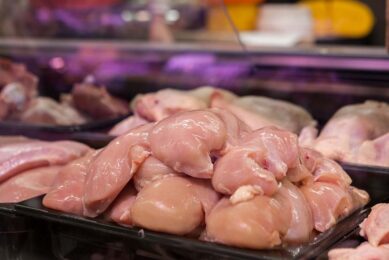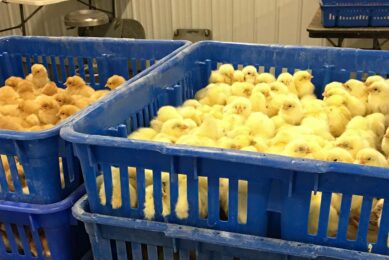Revolution in poultry disease outbreak control
![Knowing who was on the poultry farm is essential for disease control. Many vehicles are equipped with GPS beacons, so together with location details of mobile phones almost everyone and anything can be tracked.<br />[Photo: Koos Groenewold]](https://www.poultryworld.net/app/uploads/2021/04/001_638_rb-image-2802466-848x565.jpeg)
[Photo: Koos Groenewold]
Tracking people, vehicles and other contacts in case of a disease outbreak is essential to stop the virus or bug in its tracks. Innovations in two cutting-edge systems that combine smartphone apps, powerful software and GPS technology provides lightning fast outbreak management and protection of flock health.
Two new patented biosecurity systems, one for halting disease outbreaks and one for better protecting flock health, have been introduced to officials in the United Kingdom, having already been successfully rolled out over the winter in Ontario, Canada.
Presentations on ‘Be Seen, Be Safe’ and ‘Farm Health Monitor’ were recently given by Canadian innovators Tim Nelson and Joel Sotomayor to the British Egg Industry Council and other UK farming organisations, with further meetings planned.
Nelson developed the systems because he wanted better ways to manage poultry disease to be available to the industry.
Poultry disease risk remains high
The current European risk of both low and highly-pathogenic avian influenza (AI) outbreaks is constant because the disease is carried by wild birds all over the world. In January 2016, there were almost 70 AI outbreaks in France, and over the past year, AI was detected in Germany and Hungary (in poultry), in Bulgaria (in poultry and wild birds) and in Romania (wild birds). There were also poultry outbreaks in the UK and Ghana during 2015.
AI in the US killed 48 million poultry last year
Last year also saw a highly-pathogenic AI strain lead to the loss of 48 million chickens and turkeys across 12 US states. AI outbreaks have continued into 2016 in the US, with the loss of over 400 000 chickens and turkeys in January in the state of Indiana. In addition, over 180 people across 40 states were infected with salmonella in 2015 through contact with disease-carrying chickens. There are also concerns in the US, UK and beyond that more virulent strains of the virus causing Marek’s disease could emerge.
How ‘Be Seen, Be Safe’ works
To effectively contain an outbreak, farms must be quickly quarantined and traffic to and from infected or potentially-infected farms must quickly be tracked. However, using the telephone or email to do this has its limitations, especially in quickly identifying pathways that individuals or vehicles may have followed to spread the disease. Using farm visitor log books to track movement is slow to the point of being almost pointless in an emergency. This is why Nelson and Sotomayor created ‘Be Seen, Be Safe’ (BSBS) – to provide the industry with a novel way to instantly analyse farm visit data so that outbreaks can be rapidly contained.
[Photo: Henk Riswick]
First poultry farm boundary is mapped
Before the system is turned on in any jurisdiction, the geographical boundary of each poultry farm is mapped with GPS technology called ‘geo-fencing.’ During the same period of time, anyone who regularly visits poultry farms – veterinarians, feed and pullet delivery persons, vaccination crews, salespersons and so on – downloads the encrypted BSBS smartphone app (available on all three major platforms).
Smart devices logged when crossing boundaries
The system then goes live. Anytime a system-ready smartphone or tablet (or the GPS beacon on vehicles that regularly travel to farms) enters a geo-fenced poultry farm property, BSBS is automatically triggered and the visitor is ‘greeted’ with a welcome message. At the same moment, the farmer is instantly notified of a visitor’s arrival (information on all visits to that farm is stored in an online visitor record book which farmers can access at any time using a secure personal login). The encrypted BSBS database stores farm visit information for one year, which includes farm ID, visitor ID, number of farms visited in the recent past (a risk assessment level), time in and time out.
In the event of an outbreak data is given in real-time
“The geo-fencing aspect to the system means that only on-farm visits are logged, not every movement of an individual or vehicle, which protects personal privacy,” Nelson explains. “In addition, the identity of individual visitors and farms are only accessed by authorised system administrators in an emergency outbreak situation.” When an outbreak hits, the BSBS software analyses the entire database of visitor and vehicle movements at lightning speed, starting with a specific flagged farm. Disease spread is mapped and extrapolated in real time, with factors like wind speed and direction, humidity and temperature added to the map. Farmers and visitors are immediately notified by system generated text message that there is a problem, and recommended to implement quarantine and other biosecurity measures. In addition, the administrator has the ability to broadcast instant messages to all users of the system.
‘Be Seen, Be Safe’ has been rolled out in Ontario over the winter, with the involvement of over 800 geo-fenced farms and over 1200 people and vehicles. Every producer belonging to Egg Farmers of Ontario, the Ontario Broiler Hatching Egg & Chick Commission and the Turkey Farmers of Ontario are taking part. These associations have paid the first two years’ nominal cost for each farm for initial geo-fencing and monitoring, with 75% of that cost being reimbursed by a Canadian federal government grant. Nelson says support for the system has been overwhelming in Ontario, with everyone understanding that BSBS is secure, and no more intrusive than what came before (physically signing a farm visitor log book).
Farm Health Monitor
Nelson and Sotomayor have also developed ‘Farm Health Monitor’ (FHM), which permits all farmers and veterinarians in a given area to better contain and manage production-limiting diseases. Like BSBS, FHM also involves a secure smartphone app where farmers and veterinarians can input information on disease symptoms (clinical signs). If similar information is reported on two or more farms within a given area, FHM sends out a blanket warning across the region, prompting producers and vets to check flocks carefully, take samples for diagnosis and to report as necessary. Nelson calls it “a true early warning system.” Trials are currently being conducted with the poultry FHM app. The swine version is ready for trial and a dairy version is under development. The ability to upload pictures and a short video is also being added.









 Beheer
Beheer WP Admin
WP Admin  Bewerk bericht
Bewerk bericht